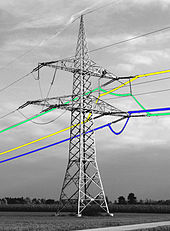Twisting mast
In electrical power engineering, a twisting mast is a guy mast on which some or all of the outer conductors of a circuit swap places on the mast. Such a twist improves the transmission behavior and is worthwhile for overhead lines from 110 kV that are longer than 20 km.
There are different twisting schemes for the execution and placement of the twists .
Take advantage of twist
The line coverings of the outer conductors of an overhead line cannot be identical for structural reasons, which, according to line theory, leads to different line properties of the individual outer conductors. An attempt is made to adjust these differences by twisting, especially the capacitance per unit length . The outer conductors form a capacitance with the ground and with the earthed overhead line pylons . The further away an outer conductor is installed from the ground or the mast, the lower its capacity. The twisting adjusts the capacities of the outer conductors to one another and thus reduces transmission losses due to reactive current . It is essential that the conductor capacitances to the earth potential are as equal as possible, even with earth fault compensation .
Twisting can also be carried out in the span between two masts, but this is not possible in Germany due to the lower operational reliability (the ladder can be folded together).
Examples
Twist mast (left) of a 110 kV line in a one- level arrangement
Twisting a medium voltage line in Japan
Twist mast of a traction power line
literature
- Réne Flosdorff, Günther Hilgarth: Electrical energy distribution . 8th edition. Teubner, 2003, ISBN 3-519-26424-2 .







